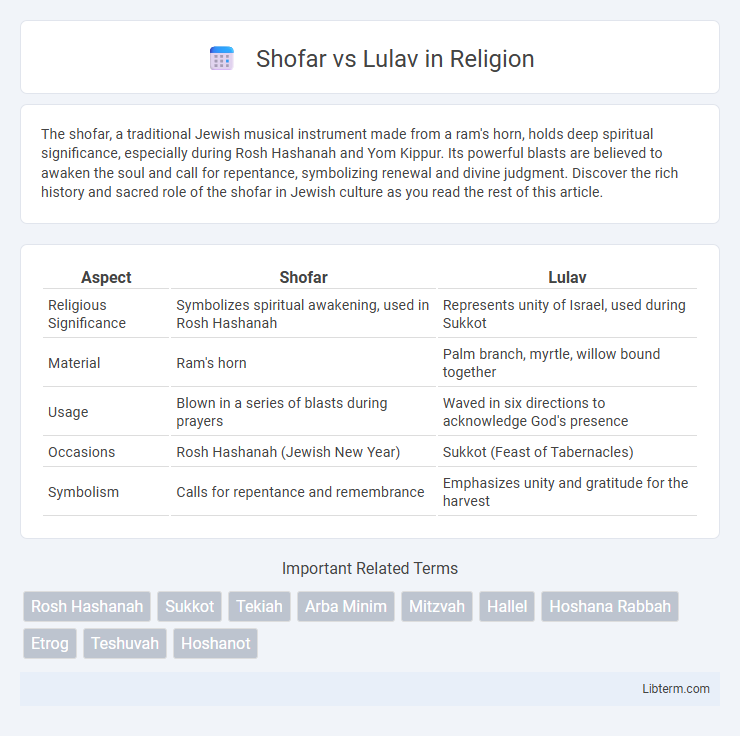The shofar, a traditional Jewish musical instrument made from a ram's horn, holds deep spiritual significance, especially during Rosh Hashanah and Yom Kippur. Its powerful blasts are believed to awaken the soul and call for repentance, symbolizing renewal and divine judgment. Discover the rich history and sacred role of the shofar in Jewish culture as you read the rest of this article.
Table of Comparison
| Aspect | Shofar | Lulav |
|---|---|---|
| Religious Significance | Symbolizes spiritual awakening, used in Rosh Hashanah | Represents unity of Israel, used during Sukkot |
| Material | Ram's horn | Palm branch, myrtle, willow bound together |
| Usage | Blown in a series of blasts during prayers | Waved in six directions to acknowledge God's presence |
| Occasions | Rosh Hashanah (Jewish New Year) | Sukkot (Feast of Tabernacles) |
| Symbolism | Calls for repentance and remembrance | Emphasizes unity and gratitude for the harvest |
Introduction: Shofar vs Lulav
The Shofar and Lulav are significant ritual objects in Jewish tradition, each representing unique spiritual symbolism and used during different religious observances. The Shofar, a ram's horn, is prominently blown during Rosh Hashanah and Yom Kippur to inspire repentance and reflection. The Lulav, consisting of palm, myrtle, and willow branches, is waved during Sukkot as a symbol of unity and gratitude for the harvest.
Historical Origins of the Shofar
The shofar, an ancient musical instrument crafted from a ram's horn, holds deep historical significance in Jewish tradition dating back to biblical times, where it was used for religious ceremonies, including the revelation at Mount Sinai and calls to battle. Unlike the lulav, which is part of the Four Species used during the festival of Sukkot symbolizing unity and agricultural blessings, the shofar represents spiritual awakening and divine communication. Archaeological evidence and scriptural references from the Torah underscore the shofar's role in ancient Israelite worship and communal gatherings.
Historical Origins of the Lulav
The lulav, a central ritual object during the Jewish festival of Sukkot, originates from ancient agricultural practices symbolizing the harvest season in the Land of Israel. Its historical roots can be traced to biblical commandments in Leviticus 23:40, where the four species--palm branch (lulav), myrtle, willow, and etrog--are gathered and waved to express gratitude for the bounty. Unlike the shofar, which has origins in ancient Near Eastern warfare and religious signaling, the lulav's significance lies in its connection to fertility, nature, and unity within the Jewish agricultural calendar.
Religious Significance of the Shofar
The Shofar, a ram's horn blown during Jewish religious ceremonies, holds profound spiritual significance as a call to repentance and a symbol of God's presence, particularly on Rosh Hashanah and Yom Kippur. Unlike the Lulav, which is a binding of palm, myrtle, and willow branches used during Sukkot to represent unity and divine blessing, the Shofar serves as a powerful auditory reminder of faith, judgment, and renewal. Its sound is deeply embedded in Jewish liturgy and tradition, marking pivotal moments in the religious calendar with themes of introspection and divine sovereignty.
Religious Meaning of the Lulav
The lulav, a central element in the Jewish festival of Sukkot, symbolizes unity and divine blessings, consisting of a palm branch bound with myrtle and willow. It represents the connection between different types of Jews, reflecting harmony and communal prayer for a fruitful year. Unlike the shofar, which is blown during Rosh Hashanah to signify repentance and alertness, the lulav is waved as a gesture of thanksgiving and spiritual purification.
When Is the Shofar Used?
The shofar is primarily used during the Jewish High Holy Days, notably on Rosh Hashanah and at the end of Yom Kippur, serving as a call to repentance and spiritual awakening. Unlike the lulav, which is integral to the Sukkot festival and waved during daily prayers, the shofar's sound marks key moments of reflection and renewal in the Jewish calendar. Its blowing signifies the beginning of the new year and concludes the fast day, symbolizing a divine awakening and remembrance.
When Is the Lulav Used?
The Lulav is used during the Jewish festival of Sukkot, specifically throughout the seven days of the holiday, excluding Shabbat. It is part of the Four Species ritual, where the lulav (palm branch) is bound together with hadassim (myrtle) and aravot (willow) and waved in six directions to symbolize God's presence everywhere. Unlike the shofar, which is primarily blown on Rosh Hashanah and Yom Kippur, the lulav is unique to Sukkot observances.
Ritual Practices: Blowing the Shofar
The ritual practice of blowing the Shofar involves producing a powerful, resonant sound using a ram's horn during significant Jewish holidays such as Rosh Hashanah and Yom Kippur, symbolizing spiritual awakening and repentance. In contrast, the Lulav ritual entails the shaking of a bound palm branch along with myrtle and willow during Sukkot to express unity and divine blessing. While both are essential in Jewish liturgy, the Shofar emphasizes auditory invocation, whereas the Lulav focuses on physical movement and symbolic symbolism.
Ritual Practices: Waving the Lulav
Waving the Lulav is a central ritual during the Jewish festival of Sukkot, involving the bundled palm branch, myrtle, and willow waved in six directions to symbolize God's omnipresence. This practice contrasts with the Shofar's use during Rosh Hashanah and Yom Kippur, where the ram's horn is blown to awaken spiritual introspection. The Lulav's ritual waving serves as an expression of unity and prayers for a fruitful harvest.
Shofar and Lulav: Comparative Symbolism
The Shofar, a ram's horn blown during Jewish High Holidays, symbolizes spiritual awakening and divine revelation, while the Lulav, a palm branch used during Sukkot, represents unity and the harvest's blessing. Both serve as ritual objects that connect worshippers to God, yet the Shofar's sound calls for repentance and reflection, contrasting with the Lulav's physical waving, which signifies joy and communal harmony. These symbols embody distinct aspects of Jewish faith: the Shofar heralds introspection, and the Lulav celebrates gratitude and nature's abundance.
Shofar Infographic

 libterm.com
libterm.com